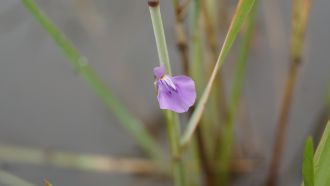Media release
From:
Australian Institute of Botanical Science researchers have discovered a threatened carnivorous plant for the first time in decades.
While there have been numerous searches for the elusive bladderwort, theirs is the first to record it at Kununurra in Western Australia since two original collections were recorded in 1978 and 1982.
Dr Richard Jobson had tried four times to look for the swamp dwelling bladderwort, known as Utricularia baliboongarnang, in the Kimberley region.
It just so happened that on his trip with student Paulo Baleeiro in March last year that the pair got their lucky break.
“The area is dry most years and we just happened to strike a year with a really good wet season,” Dr Jobson said.
“What we found was located in a ‘highly restricted’ area, in a habitat on the edge of the Ord River which is infested with crocodiles. We virtually had to circumnavigate the large swamp which is more than 4km in circumference.”
The pair encountered crocodile nests during their survey of the Parry Lagoon site near Wyndam which meant they had to stick to safe locations.
“We actually walked past it, but then went back over a nice looking area. They are really hard to see so it was really exciting to finally find it,” Dr Jobson said.
The pair have reported their findings in the Telopea journal.
They consulted with Miriwoong Elders and senior speakers of the Mirima Dawang Woorlab-gerring Language and Culture Centre to select the plant’s name.
In the Miriwoong Language the word Baliboong refers to a swamp habitat, and the chosen name baliboo-ngarnang means “swamp-dwelling”.
“Work like this is important in understanding the true distribution of rare and threatened plants so we can better conserve and manage their habitats,” Dr Jobson said.
The plant has two different types of bladder traps it uses to catch different prey such as tiny crustaceans, nematodes and water mites. It grows in wet sand in large swamps and flowers from March to April.
The researchers recommend that further surveys are required of other swamps in the region to fully understand the plant’s distribution. This data is required to formally assess its conservation status.
Multimedia




 Australia; WA
Australia; WA

